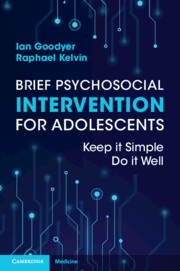Book contents
- Brief Psychosocial Intervention for Adolescents
- Brief Psychosocial Intervention for Adolescents
- Copyright page
- Contents
- Acknowledgements
- 1 Adolescence and the Psychotherapies
- 2 Evidence-Based Psychotherapy
- 3 Evolving the BPI Method
- 4 The Evidence Base for BPI
- 5 Practice Framework and Clinical Principles
- 6 Clinical Styles and Therapy Tools
- 7 BPI in Clinical Practice: Part One
- 8 BPI in Clinical Practice: Part Two
- 9 Top Tips for Best Practice
- Index
9 - Top Tips for Best Practice
Published online by Cambridge University Press: 16 March 2023
- Brief Psychosocial Intervention for Adolescents
- Brief Psychosocial Intervention for Adolescents
- Copyright page
- Contents
- Acknowledgements
- 1 Adolescence and the Psychotherapies
- 2 Evidence-Based Psychotherapy
- 3 Evolving the BPI Method
- 4 The Evidence Base for BPI
- 5 Practice Framework and Clinical Principles
- 6 Clinical Styles and Therapy Tools
- 7 BPI in Clinical Practice: Part One
- 8 BPI in Clinical Practice: Part Two
- 9 Top Tips for Best Practice
- Index
Summary
We have noted that, in our view, when undertaking any psychotherapy there should be supervision and reflective practice throughout one’s career. Senior therapists can be as much in need of discussions about their cases as newly qualified practitioners. Until we have much improved our understanding of what intervention works for which patient and how, we recommend supervision as a key clinical tool in learning the skills and techniques of BPI. Of course, we do not yet know which of these tips is responsible for clinical effectiveness. Therefore, regular fortnightly supervision with a senior, more experienced colleague is sound practice. Table 9.1 describes key general components that should activate a discussion with your supervisor.
- Type
- Chapter
- Information
- Brief Psychosocial Intervention for AdolescentsKeep it Simple; Do it Well, pp. 102 - 114Publisher: Cambridge University PressPrint publication year: 2023

